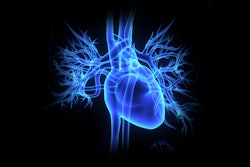Photon-counting detector CT (PCCT) with virtual monoenergetic imaging (VMI) reconstruction shows promise for quantifying stenosis with coronary CT angiography (CCTA), according to a study published January 10 in the American Journal of Roentgenology.
"When performing coronary CTA by [PCCT], the selection of VMI level influences stenosis assessment in calcified and mixed plaque, thereby potentially impacting clinical decision-making," said corresponding author Tilman Emrich, MD, from the University Medical Center, Mainz, in Germany in a statement released by the journal.
Coronary CTA is commonly used to assess stable coronary artery disease (CAD), but can be limited by conventional CT, producing low positive predictive values (PPV), "due mainly to artifacts such as calcium blooming that lead to stenosis overestimation" -- which in turn can prompt patients to be referred for invasive coronary angiography, the group noted. That's why PCCT shows promise, since it offers improved spatial resolution, reduced image noise, and high temporal resolution.
"In particular, [PCCT] may allow reduction of overestimation bias in coronary stenosis quantification through use of VMI reconstructions at optimal energy levels," the investigators explained.
To explore PCCT's benefits for assessing stenosis, Emrich and colleagues used a phantom that consisted of two custom-made vessels mimicking 25% and 50% stenoses, imaging it with PCCT with and without simulated cardiac motion. They then compared data from these images to data from 33 patients with 64 cardiac stenoses who underwent coronary CTA with PCCT.
The researchers reconstructed the scans as nine VMI levels (ranging from 40 keV to 140 keV) and measured percentage diameter stenosis. They also measured the extent of "blooming artifacts" in the phantom and calcified and mixed plaques in the patients.
The team found the following:
| Impact of virtual monoenergetic imaging on stenosis quantification using PCCT, phantom | ||
|---|---|---|
| Measure | 25% stenosis phantom | 50% stenosis phantom |
| Percentage diameter stenosis | ||
| 40 keV | 59.9% | 81.6% |
| 140 keV | 13.4% | 42.3% |
| Blooming artifacts | ||
| 40 keV | 61.5% | 82.7% |
| 140 keV | 35.4% | 52.1% |
| Impact of virtual monoenergetic imaging on stenosis quantification using PCCT, patients | ||
|---|---|---|
| Percentage diameter stenosis for type of plaque | 40 keV | 140 keV |
| Calcified plaque | 70.8% | 57.3% |
| Mixed plaque | 69.8% | 56.3% |
| Noncalcified plaque | 46.6% | 54.6% |
"The use of dual-energy [PCCT] with VMI reconstruction at varying energy levels to optimize stenosis quantification could enhance the role of coronary CTA in clinical risk assessment and decision-making," the authors concluded.
 82-year-old man with calcified stenosis in left main artery who underwent coronary CTA by PCCT. Curved multiplanar reformatted images at varying virtual monoenergetic imaging (VMI) levels (40-140 keV) show stenosis at each level. Percent diameter stenosis (PDS) decreased from 92.5% at 40 keV to 53.1% at 140 keV. Extent of calcium blooming artifacts decreased from 100% at 40 keV to 72.3% at 140 keV. Image and caption courtesy of the American Journal of Roentgenology.
82-year-old man with calcified stenosis in left main artery who underwent coronary CTA by PCCT. Curved multiplanar reformatted images at varying virtual monoenergetic imaging (VMI) levels (40-140 keV) show stenosis at each level. Percent diameter stenosis (PDS) decreased from 92.5% at 40 keV to 53.1% at 140 keV. Extent of calcium blooming artifacts decreased from 100% at 40 keV to 72.3% at 140 keV. Image and caption courtesy of the American Journal of Roentgenology.
The complete study can be found here.




















